| |
| |
Photographer,
Location |
Images |
Comments |
|
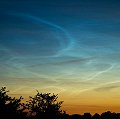
|
Marek
Nikodem,
Szubin, Poland
Jul. 2, 2008 |
#1,
#2, #3,
more |
Noctilucent
clouds attack! Today morning, before 2 hours of sunrise,
I observation great complex NLC. The display was over 90
degrees wide, over 30-40 degrees high. Photo detalis: Nikon
D50 camera, exp 6-8 sec, iso 400 ASA |
|
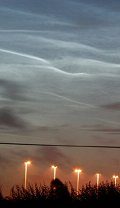
|
John
C McConnell,
Maghaberry Northern Ireland.
Jul. 2, 2008 |
#1,
#2,
#3,
#4 |
The
NLC display lasted all night here in Northern Ireland. These
images show the amazing structure visible just before dawn.These
bands were so compact that they cast their own shadows on
the sky, I have never seen that before in over forty years
of observing NLC's.Canon 400D 18-55mm lens ISO400/200 various
exposures from 8-3.2 seconds. |
|
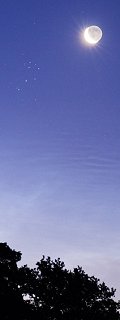
|
Laurent
Laveder,
Quimper, Bretagne, France
Jun. 30, 2008 |
#1,
#2,
#3,
#4,
more |
It
was a nice Moon-Pleiades conjunction, and an exceptional
day for me because it was the first time ever I saw some
noctilucent clouds! And this display was very broad as it
extend from North-East to East! I made some panoramas using
a Sigma 70mm stop to f/4.0 on a Canon 30D. No tracking.
3 s at 500 ASA. |
|
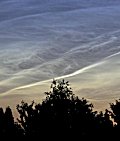
|
Henk
Bril,
Nieuwstadt, Limburg, The Netherlands
Jul. 2, 2008 |
#1,
#2, #3,
#4, more |
Most
spectacular show I've ever observed of NLCs. On the evening
of July 1st a modest but nice performance, but on the early
morning a eruption of activity that lasted until sunrise.
Even surpassing the zenith, which must be quite rare for
my latitude (+51 North) |
|

|
Pete
Lawrence,
East Beach, Selsey, West Sussex, UK
Jun. 30, 2008 |
#1,
#2, #3,
#4, more |
Wow!
I was just packing up for the night when I spotted another
display of NLCs at the edge of the twilight arc to the north-east.
I grabbed my camera and popped down to the beach where a
lovely crescent Moon posed beautifully amongst the clouds.
Then, just when I thought it couldn't get any better - I
spotted the Pleiades in one of my shots. A superb way to
end a night's observing. What a sight! |
|
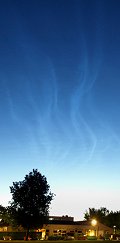
|
Sietse
Dijkstra,
Almelo, The Netherlands
Jun. 30, 2008 |
#1,
#2,
#3, |
The
morning before we go on holiday! So my camera was allready
packed, but for this display I get it out the car to take
these pictures. Very bright display wich reaches hights
till 60 degrees. Pictures taken from a field behind my house
in Almelo, the Netherlands. Sorry for my bad English ;)
|
|
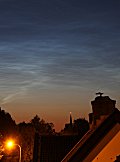
[movie]
|
Peter
van Leuteren,
Borne, Overijssel, the Netherlands
Jul. 2, 2008 |
#1,
movie, more |
After
a night of meteor watching, in which I saw a beautiful sporadic
fireball meteor of magnitude -4, I photographed the noctilucent
clouds seen from my bedroom window. It was a beautiful and
bright display. During the display I had telephone contact
with a friend that was on vacation in Drenthe (100 kilometres
in the north of were I live). He saw the same details in
the clouds as I did. That whereas we were so far away from
each other. |
|
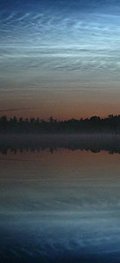
|
Stachu
Strzyzewski,
Reszel, Northern Poland
Jun. 26, 2008 |
#1,
#2 |
What
a show! The noctilucent clouds lasted over northern horizon
for the entire night creating glowing patches, ripples and
waves until dawn. I haven't seen them that bright and long
lasting so far. |
more
images (July 2): from
Pete Glastonbury of Devizes, Wiltshure, UK; from
Raymond Westheim of Oss, The Netherlands; from
Lukas Ronge of Trutnov, Czech Republic
more
images: (June 30): from
Andy Ball of Worcester, Midlands, England; from
Martin Stirland of Winterton On Sea Norfolk England; from
David Arditti of Edgware, Middlesex, UK; from
Scotweather of Falkirk, Scotland; from
Alan C Tough on the North Sea (approx. 51 deg 48' N; 2 deg
38' E); from
Andy Burns of Bedroom, Chippenham, Wiltshire, UK;
more
images: (June 26): from
Christian Bartzsch of Riesa, Saxony, Germany;
|
|









